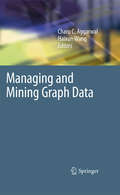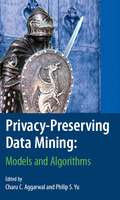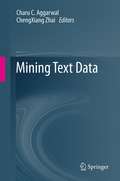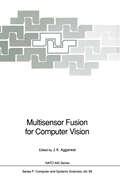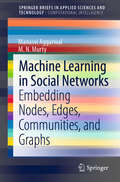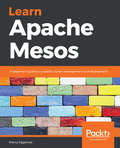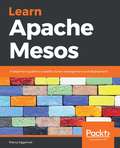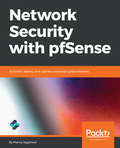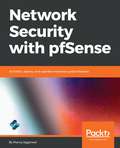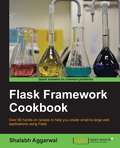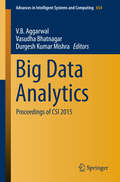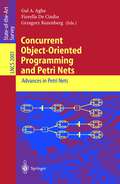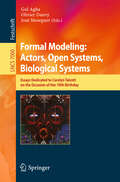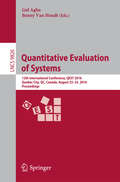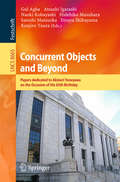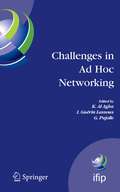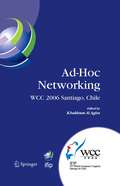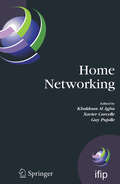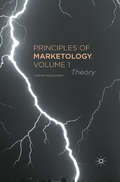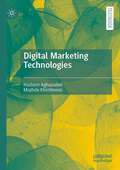- Table View
- List View
Managing and Mining Graph Data (Advances in Database Systems #40)
by Charu C. Aggarwal Haixun WangManaging and Mining Graph Data is a comprehensive survey book in graph management and mining. It contains extensive surveys on a variety of important graph topics such as graph languages, indexing, clustering, data generation, pattern mining, classification, keyword search, pattern matching, and privacy. It also studies a number of domain-specific scenarios such as stream mining, web graphs, social networks, chemical and biological data. The chapters are written by well known researchers in the field, and provide a broad perspective of the area. This is the first comprehensive survey book in the emerging topic of graph data processing. Managing and Mining Graph Data is designed for a varied audience composed of professors, researchers and practitioners in industry. This volume is also suitable as a reference book for advanced-level database students in computer science and engineering.
Privacy-Preserving Data Mining: Models and Algorithms (Advances in Database Systems)
by Charu C. Aggarwal Philip S. YuAdvances in hardware technology have increased the capability to store and record personal data. This has caused concerns that personal data may be abused. This book proposes a number of techniques to perform the data mining tasks in a privacy-preserving way. This edited volume contains surveys by distinguished researchers in the privacy field. Each survey includes the key research content as well as future research directions of a particular topic in privacy. The book is designed for researchers, professors, and advanced-level students in computer science, but is also suitable for practitioners in industry.
Mining Text Data
by Charu C. Aggarwal ChengXiang ZhaiText mining applications have experienced tremendous advances because of web 2.0 and social networking applications. Recent advances in hardware and software technology have lead to a number of unique scenarios where text mining algorithms are learned. Mining Text Data introduces an important niche in the text analytics field, and is an edited volume contributed by leading international researchers and practitioners focused on social networks & data mining. This book contains a wide swath in topics across social networks & data mining. Each chapter contains a comprehensive survey including the key research content on the topic, and the future directions of research in the field. There is a special focus on Text Embedded with Heterogeneous and Multimedia Data which makes the mining process much more challenging. A number of methods have been designed such as transfer learning and cross-lingual mining for such cases. Mining Text Data simplifies the content, so that advanced-level students, practitioners and researchers in computer science can benefit from this book. Academic and corporate libraries, as well as ACM, IEEE, and Management Science focused on information security, electronic commerce, databases, data mining, machine learning, and statistics are the primary buyers for this reference book.
Multisensor Fusion for Computer Vision (NATO ASI Subseries F: #99)
by J. K. AggarwalThis volume contains revised papers based on contributions to the NATO Advanced Research Workshop on Multisensor Fusion for Computer Vision, held in Grenoble, France, in June 1989. The 24 papers presented here cover a broad range of topics, including the principles and issues in multisensor fusion, information fusion for navigation, multisensor fusion for object recognition, network approaches to multisensor fusion, computer architectures for multi sensor fusion, and applications of multisensor fusion. The participants met in the beautiful surroundings of Mont Belledonne in Grenoble to discuss their current work in a setting conducive to interaction and the exchange of ideas. Each participant is a recognized leader in his or her area in the academic, governmental, or industrial research community. The workshop focused on techniques for the fusion or integration of sensor information to achieve the optimum interpretation of a scene. Several participants presented novel points of view on the integration of information. The 24 papers presented in this volume are based on those collected by the editor after the workshop, and reflect various aspects of our discussions. The papers are organized into five parts, as follows.
Machine Learning in Social Networks: Embedding Nodes, Edges, Communities, and Graphs (SpringerBriefs in Applied Sciences and Technology)
by Manasvi Aggarwal M.N. MurtyThis book deals with network representation learning. It deals with embedding nodes, edges, subgraphs and graphs. There is a growing interest in understanding complex systems in different domains including health, education, agriculture and transportation. Such complex systems are analyzed by modeling, using networks that are aptly called complex networks. Networks are becoming ubiquitous as they can represent many real-world relational data, for instance, information networks, molecular structures, telecommunication networks and protein–protein interaction networks. Analysis of these networks provides advantages in many fields such as recommendation (recommending friends in a social network), biological field (deducing connections between proteins for treating new diseases) and community detection (grouping users of a social network according to their interests) by leveraging the latent information of networks. An active and important area of current interest is to come out with algorithms that learn features by embedding nodes or (sub)graphs into a vector space. These tasks come under the broad umbrella of representation learning. A representation learning model learns a mapping function that transforms the graphs' structure information to a low-/high-dimension vector space maintaining all the relevant properties.
Learn Apache Mesos: A beginner's guide to scalable cluster management and deployment
by Manuj AggarwalScale applications with high availability and optimized resource management across data centers Key Features Create clusters and perform scheduling, logging, and resource administration with Mesos Explore practical examples of managing complex clusters at scale with real-world data Write native Mesos frameworks with Python Book Description Apache Mesos is an open source cluster manager that provides efficient resource isolation and sharing across distributed applications or frameworks. This book will help you build a strong foundation of Mesos' capabilities along with practical examples to support the concepts explained throughout the book. Learn Apache Mesos dives straight into how Mesos works. You will be introduced to the distributed system and its challenges and then learn how you can use Mesos and its framework to solve data problems. You will also gain a full understanding of Mesos' internal mechanisms and get equipped to use Mesos and develop applications. Furthermore, this book lets you explore all the steps required to create highly available clusters and build your own Mesos frameworks. You will also cover application deployment and monitoring. By the end of this book, you will have learned how to use Mesos to make full use of machines and how to simplify data center maintenance. What you will learn Deploy and monitor a Mesos cluster Set up servers on AWS to deploy Mesos components Explore Mesos resource scheduling and the allocation module Deploy Docker-based services and applications using Mesos Marathon Configure and use SSL to protect crucial endpoints of your Mesos cluster Debug and troubleshoot services and workloads on a Mesos cluster Who this book is for This book is for DevOps and data engineers and administrators who work with large data clusters. You'll also find this book useful if you have experience working with virtualization, databases, and platforms such as Hadoop and Spark. Some experience in database administration and design will help you get the most out of this book.
Learn Apache Mesos: A beginner's guide to scalable cluster management and deployment
by Manuj AggarwalScale applications with high availability and optimized resource management across data centers Key Features Create clusters and perform scheduling, logging, and resource administration with Mesos Explore practical examples of managing complex clusters at scale with real-world data Write native Mesos frameworks with Python Book Description Apache Mesos is an open source cluster manager that provides efficient resource isolation and sharing across distributed applications or frameworks. This book will help you build a strong foundation of Mesos' capabilities along with practical examples to support the concepts explained throughout the book. Learn Apache Mesos dives straight into how Mesos works. You will be introduced to the distributed system and its challenges and then learn how you can use Mesos and its framework to solve data problems. You will also gain a full understanding of Mesos' internal mechanisms and get equipped to use Mesos and develop applications. Furthermore, this book lets you explore all the steps required to create highly available clusters and build your own Mesos frameworks. You will also cover application deployment and monitoring. By the end of this book, you will have learned how to use Mesos to make full use of machines and how to simplify data center maintenance. What you will learn Deploy and monitor a Mesos cluster Set up servers on AWS to deploy Mesos components Explore Mesos resource scheduling and the allocation module Deploy Docker-based services and applications using Mesos Marathon Configure and use SSL to protect crucial endpoints of your Mesos cluster Debug and troubleshoot services and workloads on a Mesos cluster Who this book is for This book is for DevOps and data engineers and administrators who work with large data clusters. You'll also find this book useful if you have experience working with virtualization, databases, and platforms such as Hadoop and Spark. Some experience in database administration and design will help you get the most out of this book.
Learn Apache Mesos: A Beginner's Guide To Scalable Cluster Management And Deployment
by Manuj AggarwalApache Mesos is an open source cluster manager which provides efficient resource isolation and sharing across distributed applications. You will learn how Mesos works and then develop applications. You will learn to make full utilization of machines and simplify the maintenance of a data center with Mesos.
Network Security with pfSense: Architect, deploy, and operate enterprise-grade firewalls
by Manuj AggarwalUse an open source firewall and features such as failover, load balancer, OpenVPN, IPSec, and Squid to protect your network Key Features Explore pfSense, a trusted open source network security solution Configure pfSense as a firewall and create and manage firewall rules Test pfSense for failover and load balancing across multiple WAN connections Book Description While connected to the internet, you're a potential target for an array of cyber threats, such as hackers, keyloggers, and Trojans that attack through unpatched security holes. A firewall works as a barrier (or shield') between your computer and cyberspace. pfSense is highly versatile firewall software. With thousands of enterprises using pfSense, it is fast becoming the world's most trusted open source network security solution. Network Security with pfSense begins with an introduction to pfSense, where you will gain an understanding of what pfSense is, its key features, and advantages. Next, you will learn how to configure pfSense as a firewall and create and manage firewall rules. As you make your way through the chapters, you will test pfSense for failover and load balancing across multiple wide area network (WAN) connections. You will then configure pfSense with OpenVPN for secure remote connectivity and implement IPsec VPN tunnels with pfSense. In the concluding chapters, you'll understand how to configure and integrate pfSense as a Squid proxy server. By the end of this book, you will be able to leverage the power of pfSense to build a secure network. What you will learn Understand what pfSense is, its key features, and advantages Configure pfSense as a firewall Set up pfSense for failover and load balancing Connect clients through an OpenVPN client Configure an IPsec VPN tunnel with pfSense Integrate the Squid proxy into pfSense Who this book is for Network Security with pfSense is for IT administrators, security administrators, technical architects, chief experience officers, and individuals who own a home or small office network and want to secure it.
Network Security with pfSense: Architect, deploy, and operate enterprise-grade firewalls
by Manuj AggarwalUse an open source firewall and features such as failover, load balancer, OpenVPN, IPSec, and Squid to protect your network Key Features Explore pfSense, a trusted open source network security solution Configure pfSense as a firewall and create and manage firewall rules Test pfSense for failover and load balancing across multiple WAN connections Book Description While connected to the internet, you're a potential target for an array of cyber threats, such as hackers, keyloggers, and Trojans that attack through unpatched security holes. A firewall works as a barrier (or shield') between your computer and cyberspace. pfSense is highly versatile firewall software. With thousands of enterprises using pfSense, it is fast becoming the world's most trusted open source network security solution. Network Security with pfSense begins with an introduction to pfSense, where you will gain an understanding of what pfSense is, its key features, and advantages. Next, you will learn how to configure pfSense as a firewall and create and manage firewall rules. As you make your way through the chapters, you will test pfSense for failover and load balancing across multiple wide area network (WAN) connections. You will then configure pfSense with OpenVPN for secure remote connectivity and implement IPsec VPN tunnels with pfSense. In the concluding chapters, you'll understand how to configure and integrate pfSense as a Squid proxy server. By the end of this book, you will be able to leverage the power of pfSense to build a secure network. What you will learn Understand what pfSense is, its key features, and advantages Configure pfSense as a firewall Set up pfSense for failover and load balancing Connect clients through an OpenVPN client Configure an IPsec VPN tunnel with pfSense Integrate the Squid proxy into pfSense Who this book is for Network Security with pfSense is for IT administrators, security administrators, technical architects, chief experience officers, and individuals who own a home or small office network and want to secure it.
Network Security with pfSense: Architect, Deploy, And Operate Enterprise-grade Firewalls
by Manuj AggarwalpfSense is the world's most trusted open source network security solution. In this book, you’ll learn about pfSense, all of its key features, how you can install and deploy it, as well as the different tasks you can perform.
Flask Framework Cookbook
by Shalabh AggarwalIf you are a web developer who wants to learn more about developing applications in Flask and scale them with industry-standard practices, this is the book for you. This book will also act as a handy tool if you are aware of Flask's major extensions and want to make the best use of them. It is assumed that you have knowledge of Python and a basic understanding of Flask. If you are completely new to Flask, reading the book from the first chapter and going forward will help in getting acquainted with Flask as you go ahead.
Big Data Analytics: Proceedings of CSI 2015 (Advances in Intelligent Systems and Computing #654)
by V. B. Aggarwal Vasudha Bhatnagar Durgesh Kumar MishraThis volume comprises the select proceedings of the annual convention of the Computer Society of India. Divided into 10 topical volumes, the proceedings present papers on state-of-the-art research, surveys, and succinct reviews. The volumes cover diverse topics ranging from communications networks to big data analytics, and from system architecture to cyber security. This volume focuses on Big Data Analytics. The contents of this book will be useful to researchers and students alike.
Creative Motion Mastery with Adobe After Effects: Learn the ins and outs of motion graphics, post-production, rotoscoping, and VFX
by Vishu AggarwalDiscover the top tricks and techniques to make the most of Adobe After Effects and elevate your graphics design skills by creating real-world projects with this comprehensive illustrated guideKey FeaturesMaster After Effects through hands-on engagement with small projects, following the best practicesLeverage the settings and uncover hidden options in After Effects to optimize your workflowAcquire skills and techniques that will set you apart from other graphic designersPurchase of the print or Kindle book includes a free PDF eBookBook DescriptionVisual effects and motion graphics are everywhere, shaping the film, TV, games, websites, and application landscape. Navigating a field this complex and ever-expanding demands more than mere familiarity with tools; you need to stand out to get ahead. Creative Motion Mastery with Adobe After Effects is the definitive guide that not only equips you with the essential skills to distinguish yourself, but also takes you through real projects that you can add to your portfolio. Guided by a hands-on learning approach, you'll master the UI, workflow, and diverse projects such as text animation, shape layers, and rotoscoping. With this newfound knowledge, you’ll take your graphic design and post-production skills to the next level using chroma keying, particle simulations, and 2D and 3D tracking. You’ll progress faster than someone taking a formal course in Adobe After Effects! And it’s not all about creating; you’ll import graphics from Illustrator and Photoshop and apply post-production effects to give them a new life. Finally, you’ll discover how seamlessly you can export and manage your projects, ensuring end-to-end coverage of all you need. By the end of the book, you’ll have a thorough understanding of Adobe After Effects, equipped with the skills and practice you need to propel your career in graphic design.What you will learnCreate and customize text layers, including text animations, using shape layersEnhance projects with audio elements and apply audio effects to shape layersDevelop editable motion graphics templates for Premiere ProImplement color correction and grading techniques to enhance footage in projectsUse rotoscoping to remove and mask objects seamlesslyGenerate realistic effects such as rain, fire, and smoke using particle simulationsMaster the art of compositing through Chroma KeyingGet to grips with 2D and 3D tracking for seamless element integrationWho this book is forThis book is for graphic designers, UX and UI designers, e-learning designers, motion graphics artists, video editors, and VFX artists. A fundamental grasp and minimal experience with After Effects will help you follow long the concepts covered in this book. Additionally, familiarity with Illustrator and Photoshop will provide an added advantage.
Social Networks: Modelling and Analysis (Advanced Research in Reliability and System Assurance Engineering)
by Niyati Aggrawal Adarsh AnandThe goal of this book is to provide a reference for applications of mathematical modelling in social media and related network analysis and offer a theoretically sound background with adequate suggestions for better decision-making. Social Networks: Modelling and Analysis provides the essential knowledge of network analysis applicable to real-world data, with examples from today's most popular social networks such as Facebook, Twitter, Instagram, YouTube, etc. The book provides basic notation and terminology used in social media and its network science. It covers the analysis of statistics for social network analysis such as degree distribution, centrality, clustering coefficient, diameter, and path length. The ranking of the pages using rank algorithms such as Page Rank and HITS are also discussed. Written as a reference this book is for engineering and management students, research scientists, as well as academicians involved in complex networks, mathematical sciences, and marketing research.
Social Networks: Modelling and Analysis (Advanced Research in Reliability and System Assurance Engineering)
by Niyati Aggrawal Adarsh AnandThe goal of this book is to provide a reference for applications of mathematical modelling in social media and related network analysis and offer a theoretically sound background with adequate suggestions for better decision-making. Social Networks: Modelling and Analysis provides the essential knowledge of network analysis applicable to real-world data, with examples from today's most popular social networks such as Facebook, Twitter, Instagram, YouTube, etc. The book provides basic notation and terminology used in social media and its network science. It covers the analysis of statistics for social network analysis such as degree distribution, centrality, clustering coefficient, diameter, and path length. The ranking of the pages using rank algorithms such as Page Rank and HITS are also discussed. Written as a reference this book is for engineering and management students, research scientists, as well as academicians involved in complex networks, mathematical sciences, and marketing research.
Concurrent Object-Oriented Programming and Petri Nets: Advances in Petri Nets (Lecture Notes in Computer Science #2001)
by Gul A. Agha Fiorella De Cindio Grzegorz RozenbergConcurrency and distribution have become the dominant paradigm and concern in computer science. Despite the fact that much of the early research in object-oriented programming focused on sequential systems, objects are a natural unit of distribution and concurrency - as elucidated early on by research on the Actor model. Thus, models and theories of concurrency, the oldest one being Petri nets, and their relation to objects are an attractive topic of study.This book presents state-of-the-art results on Petri nets and concurrent object-oriented programming in a coherent and competent way. The 24 thoroughly reviewed and revised papers are organized in three sections. The first consists of long papers, each presenting a detailed approach to integrating Petri nets and object-orientation. Section II includes shorter papers with emphasis on concrete examples to demonstrate the approach. Finally, section III is devoted to papers which significantly build on the Actor model of computation.
Formal Modeling: Essays Dedicated to Carolyn Talcott on the Occasion of Her 70th Birthday (Lecture Notes in Computer Science #7000)
by Gul Agha Olivier Danvy José MeseguerThis Festschrift volume, published in honor of Carolyn Talcott on the occasion of her 70th birthday, contains a collection of papers presented at a symposium held in Menlo Park, California, USA, in November 2011. Carolyn Talcott is a leading researcher and mentor of international renown among computer scientists. She has made key contributions to a number of areas of computer science including: semantics and verification of progamming languages; foundations of actor-based systems; middleware, meta-architectures, and systems; Maude and rewriting logic; and computational biology. The 21 papers presented are organized in topical sections named: Essays on Carolyn Talcott; actors and programming languages; cyberphysical systems; middleware and meta-architectures; formal methods and reasoning tools; and computational biology.
Quantitative Evaluation of Systems: 13th International Conference, QEST 2016, Quebec City, QC, Canada, August 23-25, 2016, Proceedings (Lecture Notes in Computer Science #9826)
by Gul Agha Benny Van HoudtThis book constitutes the proceedings of the 13th International Conference on Quantitative Evaluation Systems, QEST 2016, held in Quebec City, Canada, in August 2016. The 21 full papers and 3 tool demonstration papers presented were carefully reviewed and selected from 46 submissions. They are organized in topical sections entitled: Markov processes; tools; sampling, inference, and optimization methods; Markov decision processes and Markovian analysis; networks.
Concurrent Objects and Beyond: Papers dedicated to Akinori Yonezawa on the Occasion of His 65th Birthday (Lecture Notes in Computer Science #8665)
by Gul Agha Atsushi Igarashi Naoki Kobayashi Hidehiko Masuhara Satoshi Matsuoka Etsuya Shibayama Kenjiro TauraThis Festschrift volume includes a collection of papers written in honor of the accomplishments of Professor Yonezawa on the occasion of his 65th birthday in 2012. With a few exceptions, the papers in this Festschrift were presented at an international symposium celebrating this occasion. Also included are reprints of two of Professor Yonezawa's most influential papers on the programming language ABCL. The volume is a testament strong and lasting impact Professor Yonezawa's research accomplishments as well as the inspiration he has been to colleagues and students alike.
Challenges in Ad Hoc Networking: Fourth Annual Mediterranean Ad Hoc Networking Workshop, June 21-24, 2005, Île de Porquerolles, France (IFIP Advances in Information and Communication Technology #197)
by K. Al Agha G. Pujolle I. Guérin LassousThis book contains the refereed proceedings of the Fourth Annual Mediterranean Ad Hoc Networking Workshop, Med-Hoc-Net 2005. Med-Hoc-Net 2005 consolidated the success of the previous editions of the workshop series. It aimed to serve as a platform for researchers from academia, research, laboratories, and industry from all over the world to share their ideas, views, reults, and experiences in the field of ad-hoc networking.
Ad-Hoc Networking: IFIP 19th World Computer Congress, TC-6, IFIP Interactive Conference on Ad-Hoc Networking, August 20-25, 2006, Santiago, Chile (IFIP Advances in Information and Communication Technology #212)
by Khaldoun Al AghaPosition-based routing was originally developed for packet radio networks in the 1980s [6]. It received renewed interest during the last few years as a method for routing in mobile wireless ad hoc and sensor networks [1, 2, 4]. The general idea of is to select the next hop based on position information such that the packet is forwarded in the geographical direction of the destination. Position-based routing can be divided into two main components: the location service and position-based forwarding. The location service [5, 13] is used for mapping the unique identifier (for example an IP address) of a node to its geographical position. In mobile ad hoc networks, providing accurate location service for position based routing, with low communication overhead, appears to be more difficult task than routing itself [13]. In case of sensor networks, however, destination is a sink or base station whose position is made available to source sensors by flooding. Position-based forwarding is performed by a node to select one of its neighbors as the next hop the packet should be forwarded to. Usually, the following information is required for the forwarding decision: the node's own geographical position, the position of all neighbors within transmission range and the position of the destination. Based on this information, the forwarding node selects one of its neighbors as the next hop such that the packet makes progress toward the geographical position of the destination.
Home Networking: First IFIP WG 6.2 Home Networking Conference (IHN'2007), Paris, France, December 10-12, 2007 (IFIP Advances in Information and Communication Technology #256)
by Khaldoun Al Agha Xavier Carcelle Guy PujolleThe Home Networking Conference 2007 provided an international technical forum for experts from industry and academia everywhere in the world to exchange ideas and present results of ongoing researches in home networking. The IFIP series publishes state-of-the-art results in the sciences and technologies of information and communication. Proceedings and post-proceedings of referred international conferences in computer science and interdisciplinary fields are featured.
Principles of Marketology, Volume 1: Theory
by H. AghazadehIn Principles of Marketology, Volume 1: Theory , Aghazadeh explores the definition, origins and framework of a new methodology for helping organizations better understand their market and competition.
Digital Marketing Technologies
by Hashem Aghazadeh Mozhde KhoshnevisThis book argues that digital marketing should benefit from emerging technologies to result in sustainable competitive values for businesses in both the digital and physical worlds. It not only explores digital marketing fundamentals, analysis, strategy, practices, and implementation but also explains the applications and relationships of marketing technologies (martechs) with digital marketing; as well as offers several real cases of practicing marketing technologies. It carefully describes how modern businesses offer their value propositions both digitally and physically applying emerging technologies specifically marketing technologies (martechs) and how consumers are using these new technologies particularly artificial intelligence (ChatGPT/ OpenAI). It investigates why consumers are so intrigued and interested in digital relationships, interaction, and shopping experiences. It critically examines and argues that digital marketing has become popular among businesses as they areattempting to serve their customers better by taking advantage of using digital marketing technologies (marketchs).
